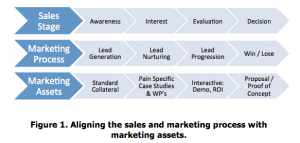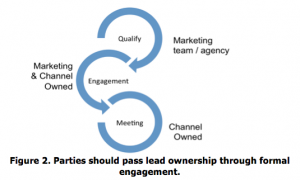Cloud Computing for Business Apps
 Cloud computing is a major component of business application software systems, and competition is fierce to convince businesses that you provide the best solutions. Cloud computing today is an important facet of business application software, but many companies are only just entering the arena.
Cloud computing is a major component of business application software systems, and competition is fierce to convince businesses that you provide the best solutions. Cloud computing today is an important facet of business application software, but many companies are only just entering the arena.
If you are a company looking to market cloud computing services to your existing customers or to a new market, it’s critical that you develop a message that demonstrates your experience and provides value to your target market.
Developing Your Message
Back in 2009, Gartner predicted, “Cloud computing is the latest super-hyped concept in IT. Although cloud computing is about a very simple idea — consuming and/or delivering services from “the cloud,” there are many issues regarding types of cloud computing and scope of deployment that make the details not nearly so simple.”
Gartner’s predictions have been manifested in a 2012 market that is full of companies clamouring for cloud computing solutions. According to Holger Kisker for Forrester, “As of the end of last year, about 30% of companies from our Forrsights Software Survey, Q4 2011, were using some software-as-a-service (SaaS) solution; that number will grow to 45% by the end of 2012 and 60% by the end of 2013.”
Another area of growth is in the development of “hybrid” cloud solutions, where some data is maintained in a private data centre and other data is maintained in a public cloud, with communications passing between the two as needed. However, this optimal solution is still a work in progress. Doug Dinely of Info World cautions, “While a certain degree of hybrid cloud goodness is available today, more pieces must fall into place before we can think seriously of using a public cloud as a seamless extension of the data center.” “The trend and related technologies continue to evolve and change rapidly, and there is continuing confusion and misunderstanding as vendors increasingly hype ‘cloud’ as a marketing term,” said David Mitchell Smith, vice president and Gartner Fellow. Part of your role as a trusted partner is to explain to your potential customers what cloud computing can do, and what its limitations are.
Some vendors may have developed experience in this area, others may be jumping on the bandwagon. No matter where your company fits into that spectrum, it’s important to make some assumptions about your target market and determine how you are going to approach that market.
First, if you’re mainly targeting “white space”, or brand new accounts that you have not worked with before, you’ll have to spend a bit more time introducing yourself and your company to these potential new accounts. Our own research has shown that the “sweet spot” for leads that are most likely to be converted for contract cloud computing solutions is the mid-sized company, or 100-250 employee range.
Second, these new accounts may have no awareness of your brand or company whatsoever. You will need to build credibility and trust with them over time before they will replace their incumbent suppliers with your solution, no matter how great your solution is. This is why “buy-or-die” simply won’t work with cloud solutions. It has to be a long-term play, where you progress deals over the medium to long term.
Finally, you may also be entering a new geographic market, and while you may have success in your home country, your reputation in these expanded markets is less well known. Once you have a feel for the requirements of your target market, you can move on to developing your message.
Vanilla Noise
One of the biggest traps you can run into when you’re developing your cloud solutions message is providing overall blanket statements that do nothing to differentiate you from your competition. These “vanilla noise” statements simply blend into what your competition is saying, and your potential customers will simply gloss over them. Some of these statements could include:
- “We can do all things Cloud” (caution: If you have no brand and you don’t establish a niche for yourself, your campaign is dead).
- “We have proven X in a different country” (caution: Demonstrate your expertise with local case studies and solutions for relevant industries).
- “We provide Y total solution” (caution: This actually makes you sound inflexible and unwilling to provide customized, bite sized solutions).
- Overly complex messaging (caution: Remember to keep your messaging simple, clear, and relevant to your target audience).
Differentiation
The key to avoiding “vanilla noise” is to differentiate yourself from your competition. With some intensive work, this can actually be quite straightforward to achieve, but many companies fail to follow the path of differentiation, and end up being overlooked by potential clients.
First, establish your niche. What is it that you do differently than your competition? Do you serve a specific market, geographical location, or specialty area that is underserved by your competition? Why are you the best in your niche?
Second, you have to provide proof to back up your claims of competence. Develop relevant case studies that focus on a specific geographical location or industry. These case studies can be used to show prospective customers that you have a proven track record.
Third, refrain from a “big bang” mentality and trying to thrust a complete yet complex solution on potential customers. Begin with a “modular” approach that you can use to respond to specific customer needs, and ramp up to more complex solutions as your relationship grows.
Working your Message
Once you have an approach and message in place, your work isn’t done. Like any marketing strategy, your cloud services messaging plan must be tested, improved, and updated as your content changes over time.
1. Adapt your message over time. Test, adapt, re-test, and customize your message to changes in your industry.
2. Reinforce your message with content. Provide your customers with customized information that is specifically relevant to them so they feel that you are providing them with additional value.
3. Provide a financial message that is simple, direct, and demonstrable.
4. Create a path for your message to make its way from mid-management to C-level enterprise decision makers. Begin by making a pitch to mid-management, who would be implementing your solutions, but adapt your pitch to C-level executives who are more concerned with value and output. Targeting C-Level contacts in white space as a starting point is usually a recipe for failure.
Differentiating your message between the end users of your services and their C-level decision makers can be a make or break action. C-level officers may not have the technical understanding of how cloud computing systems function, and may be wary of hybrid or public cloud options. James Staten of Forrester Research writing for CIO.com notes, “Work with security and risk management professionals to understand what protections must be taken for what types of data so you can determine where applications can safely be deployed. Create and publish this as a policy for all application development professionals to help guide their use of cloud resources. Also, use this guide to set the SLAs for your private cloud, whether internal or hosted.”
A Marathon, Not a Sprint
The development of a high-quality effective messaging strategy is a long term activity, not something that is planned quickly, executed, and forgotten.
Holger Kisker for Forrester notes, “Cloud-based licensing is different from traditional on-premises licensing. The traditional software sales cycle is very linear (RFI, RFP, contract, maintenance, handoff to an internal sales rep) and very static (see figure above). End users buy a license, but there is no continuous conversation with that customer. Today, SaaS vendors need to stay in constant contact with customers — something best done through an automated system that provides benefits to developers and customers alike.”
It is absolutely crucial that you develop credibility within your target market. You have to build trust over time through thought leadership, content marketing, case studies, and providing overall value no matter what the final contract is worth.
Like any marketing program, you need to have systems, processes, and programs in place to nurture leads and convert sales over the long term, such as a content marketing program and an advanced CRM system to track the performance of all of your campaigns.
You need to match appropriate marketing assets to the sales process. When leads are passed from one owner to another, there has to be a formal process in place to capture those leads and ensure they are not lost. Parties should pass ownership through formal sales engagement, as illustrated in Figure 2.
By ensuring that every lead has an owner at all times, constantly updating pipeline value and ROI, and by performing a win/loss analysis of each prospect, you can triple your ROI. Even halving the close rate on long term leads still triples the ROI.
Key Takeaways
According to Forrester research, “In 2012, cloud computing is ready for enterprise, but many enterprises aren’t ready for the cloud.” It is critical that companies like yours provide potential customers with the right information to make an informed decision about cloud computing services. To summarize the points made in this paper, here are a few key takeaways to help you improve your approach when it comes to messaging for cloud solutions:
· Remember: You are competing! Make a point to differentiate your company from your competition by focusing on a niche
· Make your solutions modular. Offer new clients a small engagement initially so they can build trust in you over time before making a larger commitment.
· If you are targeting white space, don’t only focus on C-Level contacts. Build messaging for both IT and Line-of-Business at mid-management level.
· Build a compelling message for the Finance department. Cloud can have a strong financial play.
· Focus campaigns on long-term conversion through content marketing and added value: think marathon, not sprint.
About the Author:
Mike Kelly, TSL Marketing
Mike Kelly is co-founder and EMEA Managing Director of TSL Marketing. TSL is one of the world’s leading ICT Channel Marketing Agencies. TSL help technology vendors increase their business through indirect channels, such as ISV’s, VAR’s and VAD’s.










